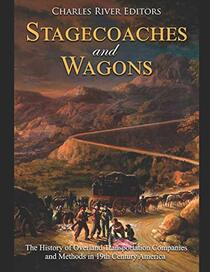This is the story of transportation in America and how it evolved over the generations. I was surprised to learn the differences between the Conestoga wagons vs. the Prairie Schooner. There are great photos to add to the readers' understanding. This is the story of the migration of Americans across the United States. The emphasis is on the wagons and stagecoaches. The early travel was not for the faint of heart; there were no roads, just narrow trails left by Indian tribes, moving to new hunting sites. This book outlines the constant innovations that made travel across the US easier and cheaper.
As other forms of transportation emerged (paddle-wheels and railroads), the stagecoaches changed their business plan from totally moving a passenger from Point A to Point B; eventually, they moved the passenger from Point A to a sailing port or railroad station.
Most of the 'trails" - such as the Oregon Trail, were really just a series of Indian and fur-hunter paths that were utilized by wagon trains, stagecoaches, and other conveyances. By constant travel, they eventually seemed to be continuous roads. One surprising fact this book brings out is that, once a traveler got started, there were few locations where they could replenish their foodstuffs. Most of the forts were concerned with trade with the Native Americans, not travelers.
I read a great deal of fiction about American pioneers and I'd always wondered why they chose oxen to pull their wagons (instead of horses or mules). This book gives the answer. In fact, this book explains a number of issues that wagons and wagon trains experienced while traversing America. This story tells how the Mexican-American War and the Gold Rush changed travel. We call the people who rushed to be some of the 49ers -- they were originally called Argonauts because so many traveled by sea (instead of overland).
There are a few paragraphs telling about how some of the most famous business names today got started. Korbel Champagne Cellars started out making cigar boxes. The stories about mail and banking are also interesting.
As other forms of transportation emerged (paddle-wheels and railroads), the stagecoaches changed their business plan from totally moving a passenger from Point A to Point B; eventually, they moved the passenger from Point A to a sailing port or railroad station.
Most of the 'trails" - such as the Oregon Trail, were really just a series of Indian and fur-hunter paths that were utilized by wagon trains, stagecoaches, and other conveyances. By constant travel, they eventually seemed to be continuous roads. One surprising fact this book brings out is that, once a traveler got started, there were few locations where they could replenish their foodstuffs. Most of the forts were concerned with trade with the Native Americans, not travelers.
I read a great deal of fiction about American pioneers and I'd always wondered why they chose oxen to pull their wagons (instead of horses or mules). This book gives the answer. In fact, this book explains a number of issues that wagons and wagon trains experienced while traversing America. This story tells how the Mexican-American War and the Gold Rush changed travel. We call the people who rushed to be some of the 49ers -- they were originally called Argonauts because so many traveled by sea (instead of overland).
There are a few paragraphs telling about how some of the most famous business names today got started. Korbel Champagne Cellars started out making cigar boxes. The stories about mail and banking are also interesting.




